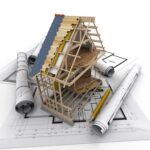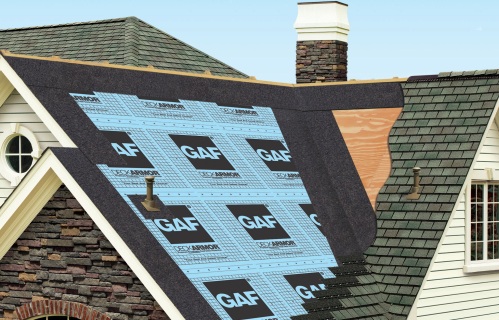Storm Damaged Roof Repair
About Your Roof
Your roof is more than just shingles. To protect your home, it must be properly constructed with quality materials by professional installers. Our representatives will educate you on top brand names and inform you of the pros and cons of all available products. We will assist you in choosing the right type and color of roofing for your home and inform you of the correct type of ventilation necessary to adequately ventilate your new roof.
The following terms may be helpful to understanding your roof.
RESIDENTIAL ROOFING TERMS AN DEFINITIONS
A.
- Algae discoloration: A type of roof discoloration caused by algae. Commonly called fungus growth.
- Asphalt: A bituminous waterproofing agent applied to roofing materials during manufacturing.
- Asphalt roofing cement: An asphalt-based cement used to bond roofing materials. Also known as flashing cement or mastic; should conform to ASTM D4586.
B.
- Base flashing: That portion of the flashing attached to or resting on the deck to direct the flow of water onto the roof covering.
- Blisters: Bubbles that may appear on the surface of asphalt roofing after installation.
- Bundle: A package of shingles. There are 3, 4 or 5 bundles per square.
C
- Caulk aka: NP1: To fill a joint with mastic or asphalt cement to help prevent leaks.
- Class “A”: The highest fire-resistance rating for roofing as per ASTM E108. Indicates roofing is able to withstand severe exposure to fire originating from sources outside the building.
- Closed cut valley: A method of valley treatment in which shingles from one side of the valley extend across the valley, while shingles from the other
side are trimmed two inches from the valley centerline. The valley flashing is not exposed. - Counter flashing: That portion of the flashing attached to a vertical surface to help prevent water from migrating behind the base flashing.
- Course: A row of shingles or roll roofing running the length of the roof.
- Cricket: A peaked saddle construction at the back of a chimney to help prevent accumulation of snow and ice and to deflect water around the chimney.
D.
- Deck: The surface installed over the supporting framing members to which the roofing is applied. Plywood or OSB sheathing.
- Dormer: A framed window unit projecting through the sloping plane of a roof.
- Downspout: A pipe for draining water from roof gutters. Also called a leader.
- Drip edge: A noncorrosive, nonstaining material used along the eaves and rakes to allow water runoff to drip clear of underlying construction.
E.
- Eaves: The horizontal, lowest edge of
a sloped roof that extends beyond the exterior wall.
F.
- Felt: Fibrous material saturated with asphalt and used as an underlayment or sheathing paper.
- Fiberglass mat: An asphalt roofing base material manufactured from glass fibers.
- Flashing: Pieces of metal or roll roofing used to prevent seepage of water into a building around any intersection or projection in a roof such as
vent pipes, chimneys, adjoining walls, dormers and valleys. Galvanized metal flashing should be minimum 26-gauge.
G.
- Gable: The upper portion of a sidewall that comes to a triangular point at the ridge of a sloping roof.
- Gable roof: A type of roof containing a sloping plane on each side of a single ridge with a gable
at each end. - Granules: Ceramic-coated colored crushed rock that is applied to the exposed surface of asphalt roofing products.
- Gutter: The trough that channels water from the eaves to the downspouts.
H.
- Hip: The inclined external angle formed by the intersection of two sloping roof planes. Runs from the ridge to the eaves.
- Hip roof: A type of roof containing sloping planes of the same pitch on each of four sides. Contains no gables.
I.
Ice dam: Condition formed at the lower roof edge by the thawing and refreezing of melted snow on the overhang. Can force water up and under shingles, causing leaks.
L.
- Laminated shingles: Strip shingles containing more than one layer of tabs to create extra thickness. Also called dimensional or architectural shingles.
- Louver: A slanted opening for ventilation.
M.
- Mansard roof: A type of roof containing two sloping planes of different pitch on each of four sides. The lower plane has a much steeper pitch than the upper, often approaching vertical. Includes no gables.
- Mineral-surfaced roofing: Asphalt shingles and roll roofing that are covered with granules.
O.
- Open valley: Method of valley construction in which shingles on both sides of the valley are trimmed along a chalk line snapped on each side of the valley. Shingles do not extend across the valley. Valley flashing is exposed.
- Overhang: That portion of the roof structure that extends beyond the exterior walls of a building.</p>
- OSB: Oriented Strand Board is a form of plywood sheathing.
P.
- Pallets: Wooden platforms used for storing and shipping bundles of shingles.
- Pitch: The degree of roof incline expressed as the ratio of the rise, in feet, to the span, in feet.
R.
- Rafter: The supporting framing member immediately beneath the deck, sloping from the ridge to the wall plate.
- Rake: The inclined edge of a sloped roof over a wall from the eave to the ridge.
- Release tape: A plastic or paper strip that is applied to the back of self-sealing shingles. This strip prevents the shingles from sticking together in the bundles and need not be removed for application.
- Ridge: The uppermost, horizontal external angle formed by the intersection of two sloping roof planes.
- Ridge shingles: Shingles used to cover the horizontal external angle formed by the intersection of two sloping roof planes.
- Rise: The vertical distance from the eaves line to the ridge.
- Roll roofing: Asphalt roofing products manufactured in roll form.
- Roofing cement: A compound used to seal flashings, seal down shingles and for other small waterproofing jobs. Where cement is required for sealing down shingles, use a dab about the size of a quarter unless
otherwise specified. - Run: The horizontal distance from the eaves to a point directly under the ridge. One half the span.
S.
- Saturated felt: An asphalt-impregnated felt used as an underlayment between the deck and the roofing material.
- Self-sealing shingles: Shingles containing factory-applied strips or spots of self-sealing adhesive.
- Self-sealing strip or spot: Factory-applied adhesive that bonds shingle courses together when exposed to the heat of the sun after application.
- Sheathing: Exterior-grade boards used as a roof deck material.
- Shed roof: A roof containing only one sloping plane. Has no hips, ridges, valleys or gables.
- Slope: The degree of roof incline expressed as the ratio of the rise, in inches, to the run, in feet.
- Soffit: The finished underside of the eaves.
- Square: A unit of roof measure covering 100 square feet.
- Starter strip: Asphalt roofing applied at the eaves that provides protection by filling in the spaces under the cutouts and joints of the first course of shingles.
- Step flashing: Flashing application method used where a vertical surface meets a sloping roof plane.
- Strip shingles: A single-layer shingle commonly known as a three-tab shingle because it has three tabs.
T.
- Tab: The exposed portion of strip shingles defined by cutouts.
- Telegraphing: A shingle distortion that may arise when a new roof is applied over an uneven surface.
- Three-dimensional shingles: See laminated shingles.
- Three-tab shingle: A single-layer shingle having three tabs.
U.
- UL: Underwriters Laboratories,
- UL label: Label displayed on packaging to indicate the listing for fire and/or wind resistance of asphalt roofing.
- Undereave: Underside area of the overhang at the eave of the roof.
- Underlayment: A layer of asphalt-saturated felt (sometimes referred to as tar paper) which is laid down on a bare deck before shingles are installed to provide additional protection for the deck.
V.
- Valley: The internal angle formed by the intersection of two sloping roof planes to provide water runoff.
- Vent: Any outlet for air that protrudes through the roof deck, such as a pipe or stack. Any device installed on the roof, gable or soffit for the purpose of ventilating the underside of the roof deck.
- Vent sleeve: See collar.
- Ventilators: Devices that eject stale air and circulate fresh air (e.g. ridge, roof, gable, undereave, foundation or rafter vents and vented soffit panels).
W.
- Woven valley: Method of valley construction in which shingles from both sides of the valley extend across the valley and are woven together by overlapping alternate courses as they are applied. The valley flashing is not exposed.


